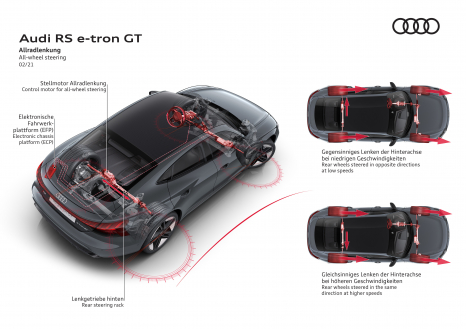Audi RS e-tron GT – Electric quattro and recuperation
The e-tron GT quattro (combined electric power consumption in kWh/100 km (62.1 mi)*: 19.6– 18.8 (NEDC), combined CO2 emissions in g/km (g/mi)*: 0) and the RS e-tron GT (combined electric power consumption in kWh/100 km (62.1 mi)*: 20.2–19.3 (NEDC), combined CO2 emissions in g/km (g/mi)*: 0) usually drive with electric all-wheel drive, with only the “efficiency” mode of the Audi drive select dynamic handling system prioritizing front-wheel drive. In the event of a slippery road surface, high power requirements, or fast cornering, more torque can be distributed to the rear wheels, and around five times faster than with a mechanical quattro drivetrain. The electric all-wheel drive regulates the drive torque distribution between the axles – continuously, fully variably, and within a few thousandths of a second. The quattro principle of the four-wheel drive that Audi introduced to the market more than 40 years ago presents itself on a new, fascinating technological level.
When the driver releases the right-hand pedal, the drive usually switches to coasting, allowing the gran turismo to glide with elegance and efficiency. By contrast, the car recuperates in overrun mode in the “dynamic” mode of Audi drive select. Regardless of the mode, the driver can use the rocker switches on the steering wheel to adjust two manual recuperation levels or select an automatic level in the MMI system. In this case, the predictive efficiency assist regulates coasting and recuperation on the basis of data from the navigation route and the on-board sensors. While braking, the electric motors perform decelerations alone up to around 0.3 g, i.e. the vast majority of all brake applications in everyday driving. This allows them to recuperate up to 265 kW of power. The hydraulic wheel brakes are activated only when the driver brakes very heavily, with recuperation remaining active almost until the vehicle comes to a standstill. In all driving situations – be it full acceleration, dynamic handling, coasting or brake recuperation – the gran turismo remains unshakably stable because its control systems for brakes, suspension, drive, and power electronics are closely connected and work together quickly. * Information on electric power consumption and CO2 emission figures given in ranges depend on the equipment selected for the vehicle.
02/2021
